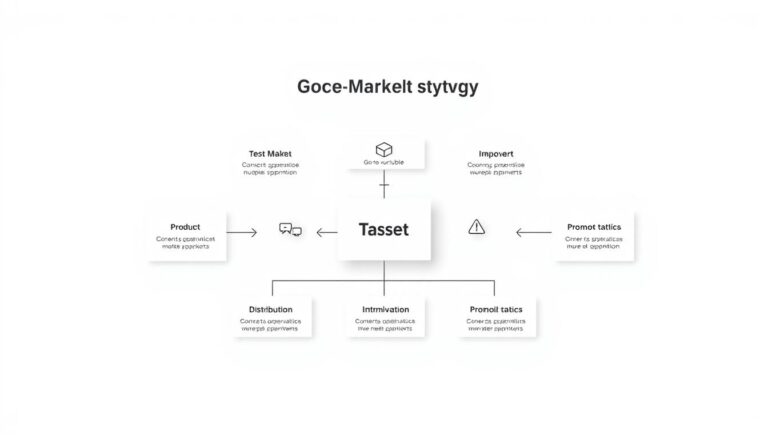In today’s fast-changing business world, using artificial intelligence (AI) can help companies stay ahead. By using AI to improve Go-To-Market (GTM) strategies, businesses can target customers better, make their messages clearer, and smooth out their sales methods. With Google Tag Manager AI integration, teams can look through huge amounts of data easily. This lets them make smarter choices that lead to making more money. Using AI to get the most out of investments is now vital for firms that want to do really well in marketing and keep doing well over time.
Key Takeaways
- AI technology is crucial for refining GTM strategies.
- Improved data analysis through Google Tag Manager enhances targeting.
- Maximizing ROI with artificial intelligence leads to better decision-making.
- AI integration can significantly improve marketing efficiencies.
- Companies need to adapt to AI advancements to remain competitive.
Understanding GTM and Its Importance for ROI
The Go-To-Market (GTM) strategy is essential for companies wanting to introduce their products well. It includes many plans and actions to attract the right customers and reach business goals. Knowing how important this strategy is helps in measuring the success of marketing efforts.
Definition of GTM (Go-To-Market) Strategy
The GTM strategy definition shows how businesses get ready to launch a new product or service. It requires deep market research, looking at competitors, and figuring out what makes the offering special for customers. A good GTM strategy makes sure the product fits what customers want and need.
Key Components of an Effective GTM Strategy
Important parts of a GTM strategy include:
- Target Audience Identification: Knowing who the customers are and their needs.
- Channel Selection: Picking the best ways to market and sell, like online or in stores.
- Product Positioning: Creating a unique offer that stands out in the market.
These key points help build a strategy that not only draws in customers but also boosts sales.
Measuring ROI in Marketing Initiatives
Checking ROI in marketing shows if GTM strategies work well. Companies need a plan to match money gained with money spent on marketing. Looking at metrics like Customer Lifetime Value (CLV), conversion rates, and costs of getting new leads helps them see results. This way, they can make their strategies better and spend resources wisely.
Knowing how a strong GTM strategy connects with smart ROI measurement can greatly help a business grow. It makes a big difference in earning more and having a better position in the market.
The Role of AI in Marketing Optimization
Artificial intelligence (AI) is changing how companies optimize their marketing. It helps businesses become more efficient and innovative. AI is great at analyzing data, giving valuable insights into customers and market trends.
How AI Enhances Data Analysis
AI tools analyze data deeply and accurately. This helps marketers understand customer behavior and trends better. AI finds patterns in large data sets, aiding in smart decision-making. So, companies can create strategies that truly meet customer needs.
Predictive Analytics for Market Insights
Predictive analytics is a key AI use, offering insights for strategic plans. It looks at past data to predict future trends. This way, businesses can be proactive and minimize risks in their marketing strategies.
Automating Routine Marketing Tasks
AI also automates daily marketing tasks. Things like data entry, emails, and social media can run automatically. This frees up staff for more important work. Automating tasks increases productivity and investment returns.

Strategies for Implementing AI in GTM
Adding AI to Go-To-Market strategies boosts efficiency and customer connections. By adopting AI, companies can make their operations smoother and base decisions on solid data. This part tells you how to make AI work well in your marketing.
Identifying Areas for AI Integration
To make the most of AI, you need to find areas where it can really make a difference. AI shines in several areas:
- Lead qualification, making it easier to spot promising customers.
- Analyzing customer habits to see what they like and do.
- Tailoring marketing better with predictive analytics.
Choosing the Right AI Tools and Technologies
Choosing the right AI tools is all about what your business needs. When picking AI tools, think about:
- How well they work with what you already have.
- If your team can easily use them.
- Whether they can grow with your business.
Being careful when you choose can avoid expensive problems and lead to success.
Setting Up AI for Continuous Improvement
For AI to really help, it needs to keep getting better. Watching how it’s doing and listening to feedback helps teams tweak things that aren’t working. Good habits include:
- Checking on AI results to ensure they’re up to snuff.
- Using feedback to make AI even better.
- Staying updated on new tech to boost AI.
Being flexible with AI lets companies stay ahead in fast-changing markets.
Data-Driven Decision Making with AI
Companies now see how crucial it is to make decisions based on data to create strong marketing tactics. They use customer data to better meet what people want and to keep customers happy. With artificial intelligence (AI), they can go through lots of data fast. This lets them make smart choices that match what people do and like.
Utilizing Customer Data to Inform GTM
For a strong marketing plan, knowing what customers like and buy is key. This information helps companies make products that people need. By using this data, they can send out better marketing messages and launch products more effectively. This way, they use what they know to grow and make more money.
Leveraging AI for Target Audience Segmentation
With AI, companies can divide their market into specific groups. This means they can send tailored messages and suggestions to each group. Because of this, they can connect better with people and sell more. AI helps them know their customers well, making sure their products hit the mark.
Enhancing Personalization through Machine Learning
Machine learning is key to making marketing more personal. It looks at past customer actions to guess what they’ll like next. This makes people more interested because they get things that matter to them. Companies using machine learning see customers stick around and feel more satisfied. This shows how important it is to use data in marketing.

Measuring and Analyzing ROI with AI Tools
It’s important to know how to measure and analyze ROI to make marketing better. We’ll look at key indicators to watch, helpful tools for tracking ROI, and examples of AI helping marketing. Using these tips, companies can get better at measuring ROI with AI.
Key Performance Indicators (KPIs) to Monitor
Choosing the right KPIs is crucial. Important metrics to look at include:
- Conversion Rates: How many people do what you want them to do.
- Customer Acquisition Costs: The cost to get a new customer.
- Customer Lifetime Value: How much money a customer brings over time.
- Return on Ad Spend: The money made from spending on ads.
Tools for Tracking and Analyzing ROI
There are many tools out there to help track ROI. Some popular ones are:
- Google Analytics: Gives details on who visits your website and their actions.
- HubSpot: Combines marketing activities and gives detailed reports.
- Pardot: Great for B2B marketing automation and understanding ROI.
- Tableau: Offers tools to see ROI metrics clearly.
Case Studies of Successful AI Implementations
Looking at real examples shows AI’s effect on marketing ROI. Here are some important ones:
A big retailer used AI to better their ad spend, increasing conversion rates by 25% in six months.
An insurance company used AI for better customer targeting, cutting acquisition costs by 40%.
Future Trends in AI and GTM Optimization
Marketing is changing fast, thanks to new tech. AI is playing a big role in this change, especially in go-to-market (GTM) strategies. It’s making companies rethink how they reach out and talk to customers.
In the years to come, we’ll see more focus on personalizing marketing. This will be backed by real-time data analysis. It means using smart algorithms to understand what customers want, making interactions smoother and more relevant.
To get ready for this AI future, companies need to invest smartly. This includes setting up good data handling systems and using tools for predicting trends. By stepping into AI now, companies can stay ahead in marketing strategies.
For those interested in how AI can help in GTM strategies, there’s more info here. It gives you a deep dive into using AI to improve your business.
FAQ
What is a Go-To-Market (GTM) strategy?
A Go-To-Market strategy is a plan on how a company will reach customers with its products. It involves knowing your audience, choosing how to distribute, and placing the product right in the market.
How does AI enhance GTM strategies?
AI boosts GTM strategies by making data analysis better. This lets companies make smarter choices. It also brings in predictive analytics for insights and automates regular marketing tasks. This improves marketing in both efficiency and effectiveness.
What metrics should be monitored when measuring ROI in marketing initiatives?
Watch key measures like how many people buy something, the cost to get new customers, how much customers engage, and if sales are going up. These metrics show if marketing strategies work and the value AI brings over old methods.
What actionable strategies can companies implement to integrate AI into their GTM framework?
Companies should find where AI fits in well, like in picking good leads or understanding customers. It’s key to pick AI tools that fit their needs well. Also, they need a way to keep improving based on feedback.
How can businesses leverage customer data for GTM strategy?
Businesses can use customer data to make GTM strategies that meet market needs well. By using AI, they can divide their audience into specific groups. This lets them target marketing better to meet different user wants and actions.
What tools are available for measuring and analyzing ROI in marketing driven by AI?
Many AI tools help track and analyze ROI. They look at things like conversion rates, how customers move through the buying process, and overall marketing success. These tools help businesses see how well their AI-powered marketing works.
What are the emerging trends in AI and GTM optimization?
New trends are focusing more on personalizing experiences, using real-time analytics, and improving how we engage customers with AI. To stay ahead, companies need to invest in new technology and foster a culture of trying new things and innovation.
How can companies prepare for future advancements in AI for GTM strategies?
Companies should invest in good tech, teach their teams about new AI tools, and encourage a culture that likes innovation. This helps them stay flexible and ready for changes in how marketing works.



